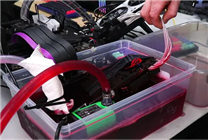Innovative Immersion Cooling: A New DIY Approach
On August 31, tech enthusiast TrashBench showcased a groundbreaking DIY immersion cooling device that has captured the attention of the tech community. Traditionally, immersion cooling technology is reserved for large-scale data centers, yet TrashBench took a bold step by using car transmission oil, a departure from the more common mineral oil typically used in such projects.
A Unique Cooling Solution
TrashBench’s innovative setup began with the careful placement of a ROG Strix GTX 1060 graphics card’s printed circuit board (PCB) and radiator into a large plastic container. By connecting the setup to an external motherboard via a PCIe extension cord, he was able to facilitate the cooling process effectively.
Next, he filled the container with transmission oil and deployed a submersible pump. This pump was critical in circulating the oil, enabling a hot and cold exchange of liquids to establish an efficient cooling cycle.
Creating a Closed-Loop System
To enhance the cooling process further, TrashBench integrated a transmission cooler from a Dodge vehicle. This component acted similarly to a radiator, cooling the heated transmission oil before recirculating it back into the container. This closed-loop system mirrored the cooling mechanisms used in automotive applications, highlighting the adaptability of automotive technology for gaming hardware cooling.
Impressive Performance Gains
After setting up the immersion cooling system, TrashBench conducted various benchmarks to evaluate performance improvements. The results were striking, showcasing an average increase of approximately 10% across different games and tests, peaking at an impressive 16% in 3DMark.
Such gains can be largely credited to the GTX 1060’s impressive clock speed, which reached an extraordinary 2190MHz. This significant boost from its original speed of 1886MHz allowed it to seize the top spot in Firestrike rankings, a testament to the effectiveness of the unique cooling setup.
Expanding the Experiment
In a further exploration of the cooling potential, TrashBench included a NVIDIA GeForce GTX 1080 Ti in his tests. Under air cooling, the 1080 Ti achieved a maximum frequency of 1960MHz. However, with transmission oil cooling, it also showed remarkable performance gains, reaching an impressive 2114MHz—an increase of around 7%.
This experimentation not only highlights the potential benefits of DIY immersion cooling but also opens up discussions on the future of PC cooling techniques, especially for high-performance gaming setups.
Cautions and Considerations
While the results of this unique immersion cooling setup are promising, TrashBench issued a cautionary note. He advised against using transmission oil for such cooling projects due to the inherent messiness associated with it. Transmission oil can easily seep into hardware components, making cleanup a daunting task and potentially leading to long-term damage.
Conclusion: A Glimpse into the Future of Cooling
TrashBench’s innovative approach to immersion cooling raises exciting possibilities for PC enthusiasts and gamers seeking to push their hardware limits. While the methodology may not be practical for everyone due to the complications involved with transmission oil, the performance gains demonstrate the untapped potential of alternative cooling solutions.
As technology progresses, we may see more unconventional methods making their way into the mainstream, offering even more efficient and effective cooling solutions to optimize performance. This experimentation serves as a reminder of how creativity and technical ingenuity can transform traditional practices in the tech landscape, encouraging a culture of innovation in hardware modifications.
Explore More: If you’re interested in learning more about innovative cooling solutions and how to enhance your gaming performance, stay tuned for more updates on the latest technologies in the computing world.







